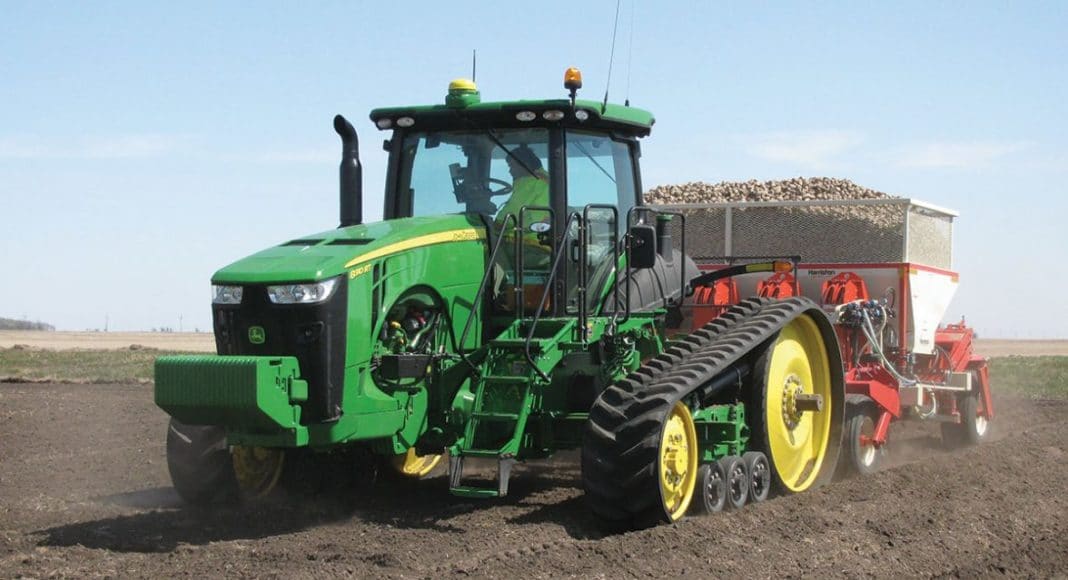[deck]Smaller tubers, yield increases, reduction in irrigation water touted as main advantages of alternative to ridged row planting.[/deck]
Five-row bed planting of potatoes comes with some inherent advantages over traditional ridged row planting. That’s the finding of a recent Manitoba study carried out to determine how different bed planting techniques can effect potato plant populations in terms of yield, tuber profile and quality for french fry processing.
Bed planting of potatoes has been gaining attention in Canada after growers in Idaho and elsewhere in the Pacific Northwest started experimenting with the technique as an alternative to the conventional ridged row system. In a bed design, multiple rows of potatoes are planted into an elevated, flat area. This configuration reduces the number of furrows in a field, thus increasing the surface area for optimal distribution of potato roots.
In 2011, Gaia Consulting was commissioned to conduct the bed planting research at Canada-Manitoba Crop Diversification Centre’s research site in Carberry, Man. Funding for the project came from the Canadian government’s Growing Forward 1 program as well as from Keystone Potato Producers Association, Simplot Canada and McCain Foods Canada.
Spud Smart first reported on the study, which compared potatoes grown in a conventional ridged row configuration to a five-row bed configuration, in our spring 2013 issue, and the results are now in.
“Tuber profile is the biggest advantage of bed planting,” says study co-author Darin Gibson of Gaia Consulting. The researchers found that bed configuration resulted in more tubers per plot, and those tubers tended to be smaller.
“Large tubers represent a real disincentive for processors,” Gibson says. “The biggest benefit we saw with bed planting is tuber size and getting more tubers of the size the processors want to see for french fry processing.”
Chad Berry can attest to bed planting’s positive effect on tuber size. Berry, owner of Over and Under the Hill Farms near Glenboro, Man., uses a bed planting system on almost one-fifth of his 1,600 acres of potatoes. It’s his fourth year using the technique, which allows him to grow five rows of potatoes in the same space where there had been four.
Fewest Benefits with Russet Burbanks
“Our quality bonuses are paid based on size profile, and it definitely helps us out there,” he says. “I find it very variety-specific, though,” he adds. According to Berry, he’s seen his most significant tuber size improvements with Innovator, Ranger, and Umatilla. He’s noticed the least amount of benefit with Russet Burbank.
One drawback researchers saw with bed planting — a slightly different tuber profile in the outer row — has been taken care of somewhat by using slightly tighter spacing in the outer row.
The study also found that bed planting produced slightly higher yields than traditional ridged row techniques — Gibson says about 25 hundredweight of additional potato yield was attained, on average. The study used a plot size of 24 by 60 feet. Eight rows of ridged rows were planted compared to 10 rows using the bed planting technique.
Berry has also noticed an average of five to 10 per cent higher yield using bed planting. “I don’t think most growers will find a very dramatic increase in yield, but it’s there,” Gibson says.
Another modest benefit to bed planting that the study authors found was in regard to irrigation water use. Because the bed planting technique allows the soil to retain more moisture, less irrigation water was required. Soil moisture was maintained at a minimum of 75 per cent available soil water, according to the study results.
Gibson adds that bed planting will likely become more popular with time, but he doesn’t expect it to become the dominant form of potato planting for the industry. “Russett Burbank is still the most widely grown variety, and we haven’t seen the benefit in that variety like we’ve seen in some of the others,” he says.
Bed planting also requires expensive equipment. Conventional planters can’t be used, meaning specialized equipment has to be brought in for seeding and possibly for other purposes. “It’s a lot of expense — you need machinery you didn’t have before,” Berry adds. He uses both conventional ridged row and bed planting on his farm. “You have to run two different units, and that means more people and more equipment.”











